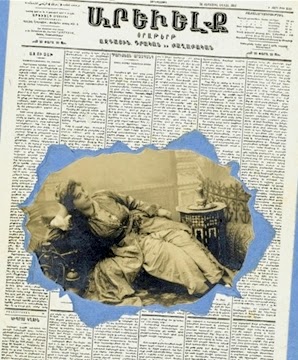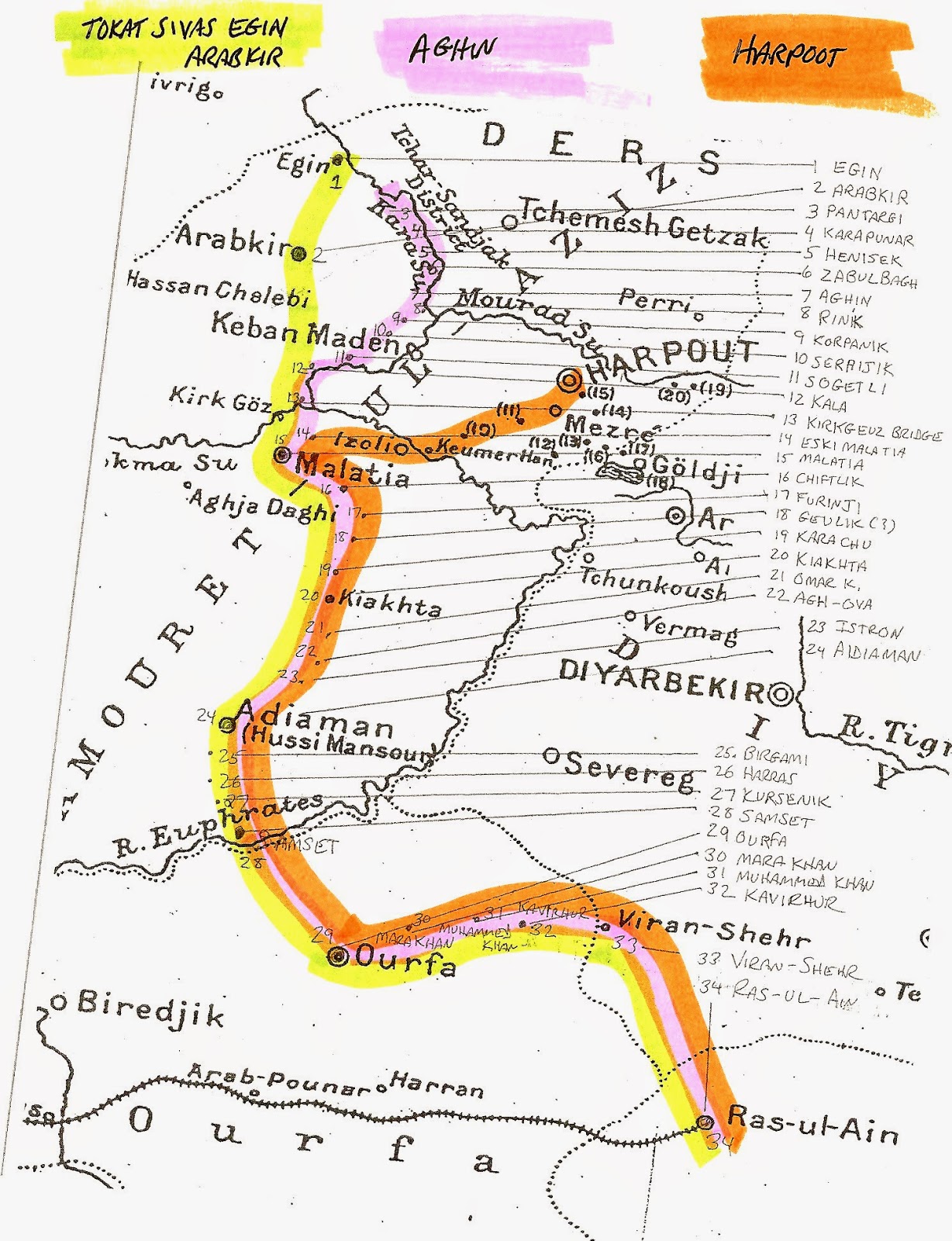READ ALMA'S STORY :
http://milhomme.blogspot.com/2012/03/from-aghin-samuel-sakaian-alma-sakaian_10.html
The Extermination Research Chronology prior to and up to the thirteenth day at Malatia
1915; April 22, Egin/Agn (province of Mamuret
ül-Aziz): Systematic searches are conducted at Agn and 248 people are
arrested. ** (Agouni, 1921: 174).
1915; May 1, Harput (province of Mamuret
ül-Aziz): Arrest of the Armenian Protestant elite, particularly the
professors of the Euphrates
College. *** (Kévorkian,
2006: 474).
1915; May 1 and 2, Çemişgezek (province of Mamuret
ül-Aziz): Raids are conducted by the authorities in schools and in the
homes of Armenian functionaries. One hundred individuals are arrested and
interned. The arrests last until June 20. *** (Kévorkian, 2006: 517).
1915; June 1, Egin/Agn (province of Mamuret
ül-Aziz): Authorities arrest Armenian religious leaders and civilians
of Agn, who are then drowned in the Euphrates (near Keban Maden) along with
some 100 other Armenian detainees. ** (Agouni, 1921: 175).
1915; June 6-20, Harput, Hüseyinig, and Mezre (province of Mamuret ül-Aziz): Authorities
carry out searches of all the homes and arrest several hundred men whose names
were on pre-existing lists. *** (Jacobsen, 2001: 68-70 and Riggs, 1997 : 75)
1915; June 7, Egin/Agn (province of Mamuret
ül-Aziz): Four hundred conscripts recruited among the male population
between the ages of sixteen to eighteen and forty-six to sixtee are tied
together in groups of five and thrown into the Euphrates at three different
spots. ** (Agouni, 1921: 175)
1915; June 14-15, Mezreh (province of Mamuret
ül-Aziz): Three thousand soldier-workers from the labor battalions of
Hoğe, Habusi, and Aşemi, along with 500 artisans from Harput, are interned at
the Kırmızı konak, outside of Mezreh. There, they are tortured and
starved. On June 18, Çerkez Kazım, one of the Commanders of the Special
Organization “militias” accompanied by cavalrymen and two hundred infantrymen,
transfers these soldier-workers to the south and has them assassinated the same
day. *** (Piranian, 1937: 98-99, 117-118; 133-139; 151-7; Riggs, 1997: 78; Atkinson,
2000: 38; and T.V. No. 3771, Jan. 13 1920: 48-49).
1915; June 19, kaza of Çemişgezek (province of Mamuret ül-Aziz): Searches
begin in the 21 Armenian villages of the kaza, particularly at Garmrig.
More than 200 men are imprisoned on July 3 and 4 and are executed in the course
of the following days by gendarmes and Special Organization bands.
***(Kévorkian, 2006: 518).
1915; June 19, kaza of Arapkir: One
hundred thirty notables of Arapkir are drowned in the Euphrates
by Special Organization bands. *** (Kévorkian, 2006: 495).
1915; June 19-22, plain of Harput: One
thousand Armenians from places around the plain and from Mezreh and Harput are
arrested in their homes and interned at the Kırmızı Konak of Mezreh. On June
23, 900 of them are dispatched and shot the day after at the foot of Mount
Heroğli by Special Organization bands commanded by Çerkez Kazım.***(Piranian,
1937: 156-1157, 167-77; Atkinson, 2000: 38; and Davis, 1994: 123).
1915; June 21, kaza of Arapkir (province of Mamuret ül-Aziz): Three hundred
men from Arapkir are drowned in the Euphrates
by S.O. gangs. ** (Kévorkian, 2006:495).
1915; June 23-24, kaza of Arapkir:
Two groups of 250 men from Arapkir are drowned in the Euphrates
by S.O. gangs. *** (Kévorkian, 2006: 495).
1915; June 24 and 25, Harput and Mezreh (province of Mamuret ül-Aziz): Police carry
out the arrest of all men; they are subsequently assassinated in the outskirts
of Harput, mostly at Gügen Boğazi, a gorge situated near Maden. *** (Riggs,
1997: 77-78; Piranian, 1937: 179-182; and Kévorkian, 2006: 477).
1915; July 1 to 5, Egin/Agn (province of Mamuret
ul-Aziz): The women, children, and elderly of Egin and 25 of its
sub-districts—some 13,000 people—are deported in three convoys to Malatya until
they reach the killing field of Fırıncılar, where a good portion of the group
is exterminated in the gorges of Kahta. ** (Kévorkian, 2006: 500-501).
**SAKAIAN’S CONVOY**
1915; July 4, province
of Mamuret ül-Aziz:
The Armenian population of Hüseyinig is deported in one convoy via Malatya. ** (Piranian,
1937: 222-227; and Atkinson, 2000: 40).
1915; July 5, province
of Mamuret ül-Aziz:
Eight hundred men from Harput and Mezreh are executed in a gorge near Hanköy by
a band of thugs who had accompanied them to their destination. ** (Atkinson:
2000: 40; Riggs, 1997: 103; and Jacobsen, 2001: 73).
1915; July 5, Arapkir (village of Mamuret
ül-Aziz): Seven thousand Armenians from Arapkir, 250 of which are men,
are deported on a convoy to Urfa.
The men are separated from the group a week later at the Kırk Göz Bridge (“The
Forty Arches”), situated on the Tohma Çay, an affluent of the right bank of the
Euphrates, and there they are shot. ***(Kévorkian, 2006: 496-497).
1915; July 10, Harput (province of Mamuret
ul-Aziz): The first convoy, made up of fifty families from the “lower
quarter” (Vari Tagh), is dispatched and escorted by “Kurds and gendarmes”. **
(Atkinson, 2000: 46; and Jacobsen, 2001: 76-77).
1915;
July 10, kaza of Çemişgezek (province
of Mamuret ul-Aziz): The population of the 21 Armenian villages of the kaza—some
3,000 individuals—is dispatched in a convoy from Arapkir to Urfa and Aleppo. Around 15% reaches its destination.
***(Kévorkian, 2006: 518).









































































